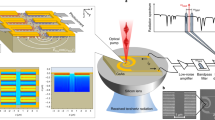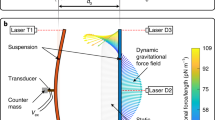Abstract
THE increasing use of ultra-short wave radio communication has created a need for the measurement of oscillating electric currents, potential differences, and field strengths, at very high frequencies, up to at least 300 megacycles per second. The difficulty of measuring these quantities can be greatly reduced by converting the original frequency to a much lower ‘intermediate’ frequency by the well-known heterodyne process, provided that the law is known which connects the amplitudes of oscillation at the two frequencies. Theory suggests that the diode frequency-changing circuit as described, for example, by Strutt1, possesses a linear conversion law if it is used with a heterodyning oscillation of sufficiently large amplitude. The linearity of this law has now been demonstrated by experiments carried out in the Radio Department of the National physical Laboratory at frequencies between 4 and 600 megacycles per second for amplitudes between about 10 and 30,000 microvolts.
This is a preview of subscription content, access via your institution
Access options
Subscribe to this journal
Receive 51 print issues and online access
$199.00 per year
only $3.90 per issue
Buy this article
- Purchase on Springer Link
- Instant access to full article PDF
Prices may be subject to local taxes which are calculated during checkout
Similar content being viewed by others
References
Strutt, M. J. O., Wireless Eng., 13, 73–80 (1936).
Harnett, D. E., and Case, N. P., Proc. Int. Rad. Eng., 23, 578–593 (1935).
George, R. W., R.C.A. Rev., 3, 431–440 (1939).
Rayleigh, Lord, Phil. Mag., 34, 125–132 (1897).
Colebrook, F. M., and Gordon-Smith, A. C., J. Inst. Elect. Eng., 84, 388–398 (1939).
Author information
Authors and Affiliations
Rights and permissions
About this article
Cite this article
GAINSBOROUGH, G. The Diode as a Frequency-Changer for Measurements at Ultra-High Frequencies. Nature 144, 548–549 (1939). https://doi.org/10.1038/144548b0
Issue Date:
DOI: https://doi.org/10.1038/144548b0
Comments
By submitting a comment you agree to abide by our Terms and Community Guidelines. If you find something abusive or that does not comply with our terms or guidelines please flag it as inappropriate.



